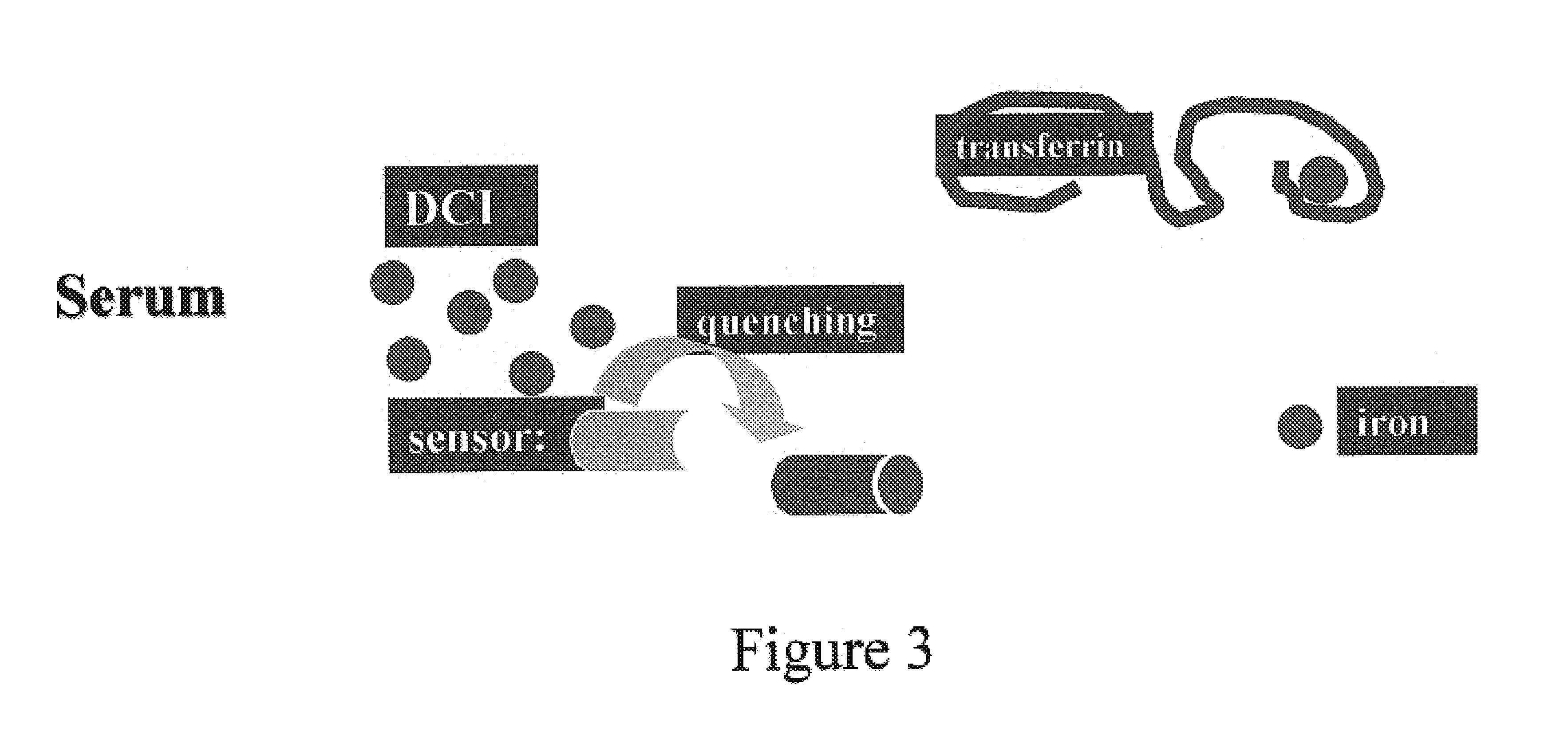Molecules and methods using same for measuring non-transferrin bound iron
a technology of non-transferrin bound iron and molecules, applied in the field of new molecules, can solve the problems of failure to detect low-moderate iron overload, no single convenient and reliable method for detecting iron-overload and specific quantification of ntbi, and often misdiagnosis of hereditary hemachromatosis, etc., to achieve straightforward, accurate and sensitive identification of free iron levels.
- Summary
- Abstract
- Description
- Claims
- Application Information
AI Technical Summary
Benefits of technology
Problems solved by technology
Method used
Image
Examples
example 1
An Assay System to Detect NTBI as DCI and MDCI
[0195]Fundamental problems in the accurate measurement of non-transferrin-bound iron (NTBI) using current methodology include the complexity, poor efficiency and hence high cost of the assay systems currently in use. Because current detection methods for non-transferrin-bound iron (NTBI) are sub-optimal, it was essential to design a more accurate assay system, with higher throughput efficiency and greater applicability in clinical settings.
[0196]While reducing the present invention to practice, a novel assay which depends on the construction of a metalosensor for detecting iron was developed. The metalosensor or iron detector is based on an iron binding moiety (i.e., iron chelating moiety, CH) and a signal generating moiety (i.e., reporter group, F) that senses the chelator-bound iron (see FIGS. 1A–D). The basic feature of the method is that the binding of the metal to the CH, and hence the change in the spectroscopic properties of F, ar...
example 2
Determination of DCI (Directly-Chelatable Iron) in Serum with FL-DFO
[0202]In order to demonstrate the versatility of the assay of the present invention, the fluorescent chelator FL-DFO, an analogue of DFO, was used to determine the directly chelatable iron (i.e., concentration of iron that is directly accessible to an iron chelator in a body fluid, DCI). The method is essentially as described for Example 1 hereinabove, and depicted schematically in FIG. 3. Note that with the designated assay conditions, no iron is chelated by FL-DFO from Tf (FIG. 3) In this DCI assay there are no agents added for mobilizing NTBI or for blocking apo-Tf in the serum sample, since Tf is mostly iron-saturated.
[0203]In order to determine assay sensitivity and provide a reference curve for the extrapolation of test results, the assay described in Example 1 was conducted on serial dilutions of known concentrations of Iron (FIG. 4).
[0204]Calibration curve generated showed fluorescence plateaus at an Iron co...
example 3
Clinical Applications of DCI Assay
[0208]In order to determine the clinical applicability of the DCI assay, chelator binding of iron from human serum samples was assayed with samples representing a variety of iron-binding pathologies, treatment protocols and assay conditions.
[0209]Assay of Desferrioxamine-chelatable Iron in Normal and Iron-Overloaded Serum—The application of the DCI assay to populations of patients with various chronic diseases of iron overload is given in Table 2, below.
[0210]
TABLE 2DCI (+)Average ofTotalSamplesDCI (+)Range of DCI (+)GroupNumber(%)(μM)(μM)Thalassemia16914.91.7–8.6major (TL)*Thalassemia11695.31.5–6.9major (IL)*HHC (Portugal)§3090.60.4–1.1HHC (NL)90——Controls§§480——Table 2 legend - TL-Thailand; IL-Israel; NL-Netherlands; HHC-hereditary Hemachromatosis;* - Sera from transfusional iron overload - predominantly β-thalassemic children in Israel and non-transfusion dependent β-EHb (variant hemoglobin E) adults in Thailand;§ - Sera from Portuguese patients ...
PUM
| Property | Measurement | Unit |
|---|---|---|
| pH | aaaaa | aaaaa |
| pH | aaaaa | aaaaa |
| pH | aaaaa | aaaaa |
Abstract
Description
Claims
Application Information
 Login to View More
Login to View More - R&D
- Intellectual Property
- Life Sciences
- Materials
- Tech Scout
- Unparalleled Data Quality
- Higher Quality Content
- 60% Fewer Hallucinations
Browse by: Latest US Patents, China's latest patents, Technical Efficacy Thesaurus, Application Domain, Technology Topic, Popular Technical Reports.
© 2025 PatSnap. All rights reserved.Legal|Privacy policy|Modern Slavery Act Transparency Statement|Sitemap|About US| Contact US: help@patsnap.com



